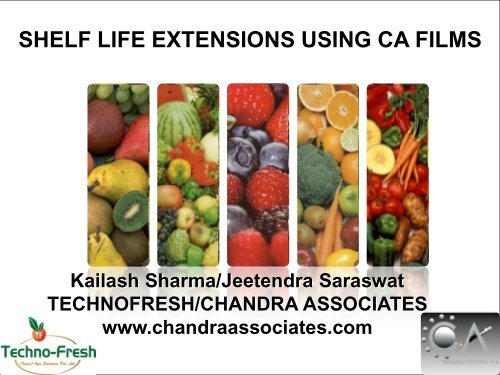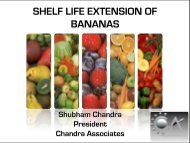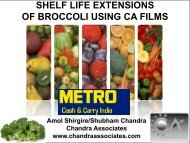SHELF LIFE EXTENSIONS USING CA FILMS - Chandra Associates
SHELF LIFE EXTENSIONS USING CA FILMS - Chandra Associates
SHELF LIFE EXTENSIONS USING CA FILMS - Chandra Associates
You also want an ePaper? Increase the reach of your titles
YUMPU automatically turns print PDFs into web optimized ePapers that Google loves.
<strong>SHELF</strong> <strong>LIFE</strong> <strong>EXTENSIONS</strong> <strong>USING</strong> <strong>CA</strong> <strong>FILMS</strong><br />
Kailash Sharma/Jeetendra Saraswat<br />
TECHNOFRESH/CHANDRA ASSOCIATES<br />
www.chandraassociates.com
<strong>SHELF</strong> <strong>LIFE</strong> <strong>EXTENSIONS</strong> <strong>USING</strong> <strong>CA</strong><br />
Program Objective:<br />
<strong>FILMS</strong><br />
1. To maintain quality and freshness of Chives for both ambient<br />
and cold chain based protocols<br />
2. To prove that designs with <strong>CA</strong> Film generate a shelf life greater<br />
than that of design without films (control in air)<br />
3. To demonstrate use of <strong>CA</strong> <strong>FILMS</strong> will lead to reduction in post<br />
harvest losses of Chives
<strong>SHELF</strong> <strong>LIFE</strong> <strong>EXTENSIONS</strong> <strong>USING</strong> <strong>CA</strong> <strong>FILMS</strong><br />
<strong>CA</strong> <strong>FILMS</strong> is a unique polymer based technology, which is capable of<br />
providing different package permeability, in order to create specific oxygen<br />
and carbon dioxide levels in a package and maintain this optimum atmosphere<br />
As the produce consumes oxygen and gives off carbon dioxide, an<br />
equilibrium gas concentration is established in the package. This process is a<br />
function of the membrane permeability and its carbon dioxide to oxygen<br />
selectivity ratio.<br />
Thus the created atmosphere is able to extend shelf life, maintain high quality<br />
and preserve nutrients of fresh produce/flowers by naturally regulating<br />
respiration of said items.<br />
MAPS extends the shelf life of fresh fruits and vegetables by passively modifying<br />
the atmosphere of a produce bag to provide the O2/Co2 levels most<br />
appropriate for that item.
Effects of temperature on quality of Chives<br />
As temperature increases, biological reaction rates increase<br />
rapidly and so does deterioration. The Q10 coefficient is a<br />
factor which measures the increase in respiration rate over a<br />
10°C range and can be used to demonstrate the perishability<br />
of herbs as temperature increases. Products with high<br />
respiration rates and short shelf-lives tend to have high Q10<br />
values<br />
Respiration rates of the fresh herbs studied increased by an<br />
average of 3.6 times between 0 and 10°C
Effects of moisture loss on quality of Chives<br />
Moisture loss is minimized by low temperatures and relative<br />
humidity greater than 95% during storage, packing, transport and<br />
marketing<br />
One of the main reasons fresh herbs are packaged in plastic films is<br />
to prevent excessive water loss The high susceptibility of fresh leafy<br />
herbs to moisture loss results in loss of marketable weight, visual<br />
quality, causes physiological stress and may reduce the product's<br />
resistance to attack by pathogens<br />
Factors that influence the rate of water loss are surface-to-volume<br />
ratios, respiration rates, storage temperature and air humidity<br />
surrounding the herb
Effects of Modified Atmosphere on quality of Chives<br />
Elevated CO2 levels in sealed packages completely overcame the<br />
senescence-promoting effect (accelerated leaf yellowing, leaf<br />
abscission and downward growth of leaf and petiole, which gives the<br />
chives a wilted look) of ethylene on yellowing-susceptible herbs<br />
Increased carbon dioxide levels and lowered oxygen levels retard<br />
chlorophyll loss and deterioration in green plant material by reducing<br />
respiration, ethylene synthesis and action, pathological breakdown<br />
Respiration levels were reduced, and chlorophyll, carotene, and<br />
Vitamin C levels were maintained longer under MA conditions<br />
compared to air storage
Effects of package type on quality of Chives<br />
after 5 days at 6°C followed<br />
by 2 days at 12°C<br />
2<br />
2.5<br />
APPEARANCE YELLOWING DE<strong>CA</strong>Y<br />
2.4<br />
PERFORATED NON-PEFORATED SEALED<br />
Appearance index: 5 = excellent, 1 = complete deterioration<br />
Yellowing and decay index: 5 = very severe, 1 = none<br />
3<br />
1.8<br />
1.8<br />
3.6<br />
1.4<br />
1.3
Chives – Supply Chain
Current problem with quality of Chives (Export)
Current problem with quality of Chives (Export)<br />
Moisture, Yellowing and decay index: 5 = very severe, 1 = none<br />
5<br />
4.5<br />
4<br />
3.5<br />
3<br />
2.5<br />
2<br />
1.5<br />
1<br />
0.5<br />
0<br />
3 3<br />
QC CHECK REPORT<br />
5<br />
3 YELLOWING<br />
DE<strong>CA</strong>Y<br />
MOISTURE<br />
BRUISING
<strong>CA</strong> <strong>FILMS</strong>®: TESTING AT AMBIENT TEMPERATURE OF 25-30° C
<strong>CA</strong> <strong>FILMS</strong>®: PROTOCOL A DAY 0 <strong>CA</strong> <strong>FILMS</strong>®: PROTOCOL BDAY 0<br />
CONTROL PROTOCOL DAY 0
<strong>CA</strong> <strong>FILMS</strong>®: PROTOCOL A DAY 2<br />
1 % Yellowing<br />
<strong>CA</strong> <strong>FILMS</strong>®: PROTOCOL B DAY 2<br />
0.5 % Yellowing<br />
CONTROL PROTOCOL DAY 2<br />
5 % Yellowing, Rotting
<strong>CA</strong> <strong>FILMS</strong>®: PROTOCOL A DAY 4<br />
2 % Yellowing<br />
CONTROL PROTOCOL DAY 4<br />
10 % Yellowing, Rotting<br />
<strong>CA</strong> <strong>FILMS</strong>®: PROTOCOL B DAY 4<br />
1 % Yellowing
<strong>CA</strong> <strong>FILMS</strong>®: PROTOCOL A DAY 6<br />
5 % Yellowing<br />
CONTROL PROTOCOL DAY 6<br />
100 % DUMP, Rotting, FUNGAL GROWTH<br />
<strong>CA</strong> <strong>FILMS</strong>®: PROTOCOL B DAY 6<br />
FUNGAL GROWTH
<strong>CA</strong> <strong>FILMS</strong>®: TESTING AT COLD TEMPERATURE OF 6° C
<strong>CA</strong> <strong>FILMS</strong>®: PROTOCOL A DAY 0 <strong>CA</strong> <strong>FILMS</strong>®: PROTOCOL B DAY 0<br />
CONTROL PROTOCOL C DAY 0
<strong>CA</strong> <strong>FILMS</strong>®: PROTOCOL A DAY 4<br />
1 % Yellowing<br />
CONTROL PROTOCOL C DAY 4<br />
5 % Yellowing<br />
<strong>CA</strong> <strong>FILMS</strong>®: PROTOCOL B DAY 4<br />
0.5 % Yellowing
<strong>CA</strong> <strong>FILMS</strong>®: PROTOCOL A DAY 7<br />
2 % Yellowing<br />
CONTROL PROTOCOL C DAY 7<br />
25 % Yellowing<br />
<strong>CA</strong> <strong>FILMS</strong>®: PROTOCOL B DAY 7<br />
5 % Yellowing
<strong>CA</strong> <strong>FILMS</strong>®: PROTOCOL A DAY 14<br />
20 % Yellowing<br />
CONTROL PROTOCOL C DAY 14<br />
80 % Yellowing<br />
<strong>CA</strong> <strong>FILMS</strong>®: PROTOCOL B DAY 14<br />
40 % Yellowing
CONCLUSIONS<br />
<strong>CA</strong> <strong>FILMS</strong>® based packaging for both ambient and<br />
cold chain protocols:<br />
ensured the reduction in moisture losses<br />
the increased carbon dioxide levels and lowered oxygen levels,<br />
intrinsic property of <strong>CA</strong> <strong>FILMS</strong>®, retarded chlorophyll loss and<br />
deterioration by reducing respiration, ethylene synthesis and<br />
action, pathological breakdown<br />
elevated CO2 levels in sealed packages completely overcame<br />
the senescence-promoting effect<br />
<strong>CA</strong> <strong>FILMS</strong>® based packaging extended the shelf life<br />
of Chives at ambient temperatures to 7+ days and at<br />
cold chain to 14+ days






